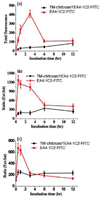N,N,N-Trimethyl chitosan nanoparticles for the delivery of monoclonal antibodies against hepatocellular carcinoma cells
- PMID: 21552341
- PMCID: PMC3088426
- DOI: 10.1016/j.carbpol.2011.02.018
N,N,N-Trimethyl chitosan nanoparticles for the delivery of monoclonal antibodies against hepatocellular carcinoma cells
Abstract
N,N,N-Trimethyl chitosan chloride is capable of forming nanocomplexes with protein through ionotropic gelation. A monoclonal antibody, raised against human liver heparan sulfate proteoglycan and specifically inhibiting hepatocellular carcinoma in vitro, was prepared in nanocomplexes of this modified chitosan. The smallest nanocomplexes (59 ± 17 nm, zeta-potential 16.5 ± 0.5 mV) were obtained at polysaccharide:antibody ratios of 5:0.3. Spherical particles with a smooth surface and compact structure having a mean diameter of ~11.2 ± 0.09 nm were investigated by Atomic Force Microscopy. Cellular uptake of fluorescently labeled nanocomplexes was studied in mouse monocyte models of cancer and normal cells. External and internal fluorescence was analyzed by flow cytometry. The results demonstrate that the nanocomplexes could enter cells and were retained for a longer period of time in cancer cells where they exhibited greater toxicity. These nanocomplexes appear safe and could potentially enhance the half-life of added antibodies.
Figures




Similar articles
-
Uptake and transport of PEG-graft-trimethyl-chitosan copolymer-insulin nanocomplexes by epithelial cells.Pharm Res. 2005 Dec;22(12):2058-68. doi: 10.1007/s11095-005-8175-y. Epub 2005 Sep 26. Pharm Res. 2005. PMID: 16170693
-
Thiolated chitosan/DNA nanocomplexes exhibit enhanced and sustained gene delivery.Pharm Res. 2007 Jan;24(1):157-67. doi: 10.1007/s11095-006-9136-9. Epub 2006 Nov 14. Pharm Res. 2007. PMID: 17103334
-
Sequentially self-assembled polysaccharide-based nanocomplexes for combined chemotherapy and photodynamic therapy of breast cancer.Carbohydr Polym. 2019 Jan 1;203:203-213. doi: 10.1016/j.carbpol.2018.09.035. Epub 2018 Sep 24. Carbohydr Polym. 2019. PMID: 30318205
-
Trimethyl-Chitosan Coated Gold Nanoparticles Enhance Delivery, Cellular Uptake and Gene Silencing Effect of EGFR-siRNA in Breast Cancer Cells.Front Mol Biosci. 2022 Apr 20;9:871541. doi: 10.3389/fmolb.2022.871541. eCollection 2022. Front Mol Biosci. 2022. PMID: 35517864 Free PMC article.
-
Thermoreversible in situ gelling poloxamer-based systems with chitosan nanocomplexes for prolonged subcutaneous delivery of heparin: design and in vitro evaluation.Eur J Pharm Sci. 2013 Sep 27;50(1):93-101. doi: 10.1016/j.ejps.2013.03.002. Epub 2013 Mar 21. Eur J Pharm Sci. 2013. PMID: 23524253
Cited by
-
A New Amphotericin B-loaded Trimethyl Chitosan Nanoparticles as a Drug Delivery System and Antifungal Activity on Candida albicans Biofilm.Arch Razi Inst. 2021 Sep 1;76(3):571-586. doi: 10.22092/ari.2020.342702.1477. eCollection 2021 Summer. Arch Razi Inst. 2021. PMID: 34824750 Free PMC article.
-
Efficient induction of antimicrobial activity with vancomycin nanoparticle-loaded poly(trimethylene carbonate) localized drug delivery system.Int J Nanomedicine. 2017 Feb 10;12:1201-1214. doi: 10.2147/IJN.S127715. eCollection 2017. Int J Nanomedicine. 2017. PMID: 28243084 Free PMC article.
-
Chitosan Nanoparticles for Therapy and Theranostics of Hepatocellular Carcinoma (HCC) and Liver-Targeting.Nanomaterials (Basel). 2020 Apr 30;10(5):870. doi: 10.3390/nano10050870. Nanomaterials (Basel). 2020. PMID: 32365938 Free PMC article. Review.
-
Characterization of a new monoclonal anti-glypican-3 antibody specific to the hepatocellular carcinoma cell line, HepG2.World J Hepatol. 2017 Mar 8;9(7):368-384. doi: 10.4254/wjh.v9.i7.368. World J Hepatol. 2017. PMID: 28321273 Free PMC article.
-
Polysaccharide-based nanocomposites and their applications.Carbohydr Res. 2015 Mar 20;405:23-32. doi: 10.1016/j.carres.2014.07.016. Epub 2014 Jul 30. Carbohydr Res. 2015. PMID: 25498200 Free PMC article. Review.
References
-
- Amidi M, Mastrobattista E, Jiskoot W, Hennink WE. Chitosan-based delivery systems for protein therapeutics and antigens. Advanced Drug Delivery Reviews. 2010;62:59–82. - PubMed
-
- Bao GQ, Li Y, Ma QJ, He XL, Xing JL, Yang XM, Chen ZN. Isolating human antibody against human hepatocellular carcinoma by guided selection. Cancer Biology & Therapy. 2005;4:1374–1380. - PubMed
-
- Befeler AS, Di Bisceglie AM. Hepatocellular carcinoma: diagnosis and treatment. Gastroenterology. 2002;122:1609–1619. - PubMed
-
- Berger J, Reist M, Chenite A, Felt-Baeyens O, Mayer JM, Gurny R. Pseudo-thermosetting chitosan hydrogels for biomedical application. International Journal of Pharmaceutics. 2005;288:17–25. - PubMed
-
- Biswas S, Bhattacharya SC, Moulik SP. Quenching of fluorescence of 1-hydroxypyrene-3,6,8-trisulfonate (HPTS) by Cu2+, Co2+, Ni2+, I−, and cetylpyridinium (CP+) ions in water/AOT/heptane microemulsion. Journal of Colloidal Interface Science. 2004;271:157–162. - PubMed
Grants and funding
LinkOut - more resources
Full Text Sources

